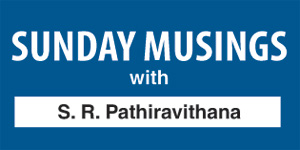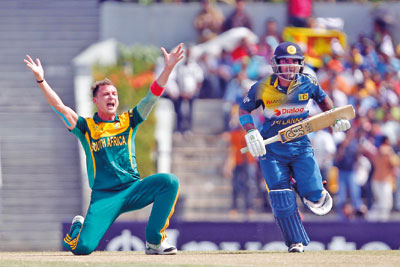Coaching or poaching — the clock is ticking now
View(s): It was not very long ago, one day, none other than the then Chief Executive Officer of Sri Lanka Cricket confronted me and lamented about poaching of cricketers by a leading school by the sea. He said he also represented that same school with distinction in the past but, he thought that it was unfair how the criteria of eligibility and the core values of participation in extracurricular activities have changed or degenerated down the line.
It was not very long ago, one day, none other than the then Chief Executive Officer of Sri Lanka Cricket confronted me and lamented about poaching of cricketers by a leading school by the sea. He said he also represented that same school with distinction in the past but, he thought that it was unfair how the criteria of eligibility and the core values of participation in extracurricular activities have changed or degenerated down the line.The ex-cricket high-up said that when they were playing for that school, the values of participation were different. It contained a lot of inner-values that helped them become useful citizens later on in their lives. Nevertheless, our team always stayed competitive and we always had good sides which generally got the better of most oppositions.
The concerned old boy added, “Now it is different. The chart of values has changed drastically. Now it is win at all costs and, if you can’t beat them, pick the best player from the opposition and get him to play for your team. Then, when that happens, it means, a player from the established playing XI of the side is on the bench. In short, the crested cap they worked a lifetime to win is either deprived or devalued.
“This happens in most of the so-called ‘big schools’, and there is hardly anything we could do to stop this growing social misdemeanour”.
Talk of children shifting schools has been there since the clock of school cricket began in Sri Lanka. But, a systematic invasion into sports’ eligibility or, in short poaching, is something new.
Yes, we have read about former National Cricketer Anuruddha Polonnowita representing both Ananda and Prince of Wales or Duleep Mendis crossing over to S. Thomas’ from St. Sebastian’s. They were not routine, but condoned. Those occurrences were far and few in between. Then, athletic legend Damayanthi Dharsha crossed over to Ladies College from a lesser known school.
Then, there are national icons in the calibre of Ranjan Madugalle crossing over from Trinity to Royal or, Marvan Atapattu shifting from Mahinda to Ananda. Those occurred when they were very young and the two cricketers played a better part of their school cricket in their adopted alma mater.
What we have learned is that, during the last two decades, the face of school sports has changed forever. Since Sri Lanka won the coveted ICC Word Cup in 1996, the growth of school cricket became phenomenal. It just burst its seams. At the same time, the cricket purse also grew significantly fatter in the years that followed. This instilled in every kid who could hold a bat straight a desire to become an Arjuna, Aravinda or a Muralitharan — and the list of icons kept growing.
At the same time, the coaching system in the so-called big schools also started to get more professionalised. Now, the former system of having one of the old boys handling the cricket or rugby outfit went out of fashion. At the same time, even the old boys of those so-called big schools became more organised and richer. All the schools wanted to produce the next Test cap or the national jersey from their school, and the job security of the coaches depended upon positive results.
This new phenomenon grew into a deadly combination. Then, wittingly or unwittingly, the school’s principal also became a part of it. Then it became a very unholy trinity.
With the Lankan economy opening up since 1977, influential personnel from the nouveau riche class started to rule the roost in every sphere of life. This resulted in the old boys unions in schools also becoming economically strong and influential. These OBUs wanted to hire the best coaches for their respective schools and win at all costs.
At the same time, the other byproduct of this cricket spread its wings. They saw more and more schoolchildren producing Sanath Jayasuriyas and Tillekeratne Dilshans – top quality cricketers coming from lesser known schools.
Now sports became a demand and supply matter in real open economics, rather than an extracurricular activity in school.

Kusal Perera: from here to there at school level and finally to the very top level in cricket - File pic
The coaches’ job is to bring positive results. Their time is limited. In most cases, they are not direct employees of the school. They are employed by the OBUs or school societies. The coach has hardly any time to experiment or change the batting grip of a batsman or, the right method of joining the line in rugby.
The result is poaching. Then, even in poaching, there are two sides to the coin. For instance, Dhanushka Ranjan was poached from Piliyandala Central to play for St. Peter’s. That move benefited both Ranjan and St. Peter’s. Today Dhanushka Ranjan is a National Rugby icon.
New kid in the cricketing bloc, Lahiru Kumara, played his initial cricket just across the fence at Sri Sumangala, before he moved to Trinity College. Within two years, he is the best known young fast bowler in Sri Lanka. I guess poaching helped both these youngsters.
However, the flip side of the coin is equally appalling. Last week, an influential former cricketer of one of those so-called big schools was in my cubical. His child also plays cricket, but this ex-cricketer does not condone poaching.
He says, in this school there is supposed to be a sports council which is also headed by a former cricketer. But, the school specialises in poaching. Be it cricket or rugby, they poach. The parents lament that, it being a semi-government entity, they levy school fees. The income to the institution through school cricket is great in rupee terms. But, the students of the school are deprived of their legitimate right to take part in sports. Before the beginning of the season, there are newcomers waiting to grab their caps and jerseys, and the poor legitimate student who has been in the school from junior level, is overlooked. Sometimes, personally notified by the so-called sports authorities, not to attend practice sessions.
The parent complained, “Just see the mental condition of the student. After engaging themselves in the sport from junior level, they are asked to give up. There is turmoil in the entire family unit. Reluctantly, some of them give up. But some, find it hard to give up, so they keep fighting. This is not the ideal situation at school level.”
The Sunday Musings wanted to see the vibes of the Department of Education on this issue. We spoke to Sunil Jayaweera – Sports Consultant to the Ministry of Education, and a man who is submerged in National sports.
Jayaweera explained, “First, the incident of such an occurrence came to our notice way back in 1994, when a certain school principal complained about their athletes being poached by bigger schools. The principal was almost on the verge of stopping all sports activities in that particular school.
“Then, after a thorough study of the situation, the Education Ministry brought in a rule meant to curb such instances. The Minister brought in regulations saying, children could change school after their GCE ‘O’ Level only for higher studies and, if any other student wants to change schools, a letter of consent is required by the principal of the school. The letter should state that the school has no objection in the student taking part in sports activity. By chance, if a student changes school without the consent of the principal of the school, the student would stay on in the school for a period of one year, before participating in any sort of competitive sport. The only higher authority who could change this stipulation is the Secretary to the Ministry of Sport.”
This is the real ground situation. But, honestly, all these cases could be taken individually and ascertained if they have been true to their hearts and abiding by the regulations, and by being engaged in such activities, whether you have really deprived a student who could stake a claim to that position.
(Also read Sports Yardstick on ST- II )


